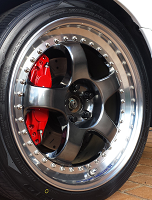I'm aware how oil grades work but u got the lower numbers mixed up 5w works For Lower temps that 10, 5 is thinner than 10 at the same temp, the low rating is needed more so if driving really cold temps of sub zero
Also 5w doesn't mean -5 or 10w =. -10 I thinkmu should read up a little on oil viscosity mark and also check your owners manual too there should be a picture showing how the oil grades recommended react at what temp
Project Veloci
- <GB>
- Posts: 2290
- Joined: Tue Nov 22, 2011 9:05 am
- Location: MELBOURNE
- Car: 08 Liberty STI
- Profile URL: viewtopic.php?f=18&t=14660
Re: Project Veloci
<GB> wrote:I'm aware how oil grades work but u got the lower numbers mixed up 5w works For Lower temps that 10, 5 is thinner than 10 at the same temp, the low rating is needed more so if driving really cold temps of sub zero
Also 5w doesn't mean -5 or 10w =. -10 I thinkmu should read up a little on oil viscosity mark and also check your owners manual too there should be a picture showing how the oil grades recommended react at what temp
Viscosity is a measure of the resistance of a fluid which is being deformed by either shear stress or tensile stress. In everyday terms (and for fluids only), viscosity is "thickness" or "internal friction". Thus, water is "thin", having a lower viscosity, while honey is "thick", having a higher viscosity. Put simply, the less viscous the fluid is, the greater its ease of movement (fluidity).
The Society of Automotive Engineers (SAE) has established a numerical code system for grading motor oils according to their viscosity characteristics. SAE viscosity gradings include the following, from low to high viscosity: 0, 5, 10, 15, 20, 25, 30, 40, 50 or 60. The numbers 0, 5, 10, 15 and 25 are suffixed with the letter W, designating their "winter" (not "weight") or cold-start viscosity, at lower temperature. The number 20 comes with or without a W, depending on whether it is being used to denote a cold or hot viscosity grade. The document SAE J300 defines the viscometrics related to these grades.
Kinematic viscosity is graded by measuring the time it takes for a standard amount of oil to flow through a standard orifice, at standard temperatures. The longer it takes, the higher the viscosity and thus higher SAE code.
The SAE has a separate viscosity rating system for gear, axle, and manual transmission oils, SAE J306, which should not be confused with engine oil viscosity. The higher numbers of a gear oil (e.g., 75W-140) do not mean that it has higher viscosity than an engine oil.
http://www.upmpg.com/tech_articles/motoroil_viscosity/
Seems GB is correct with his above statement
~JUSZTN~
** Our Turbo Lag Gives Those v8's A Chance **
History - MY07 Liberty TBSTI 6SPD Sedan
265kw atw on P100
290kw atw on E85 (fuel pump limited)
Past - MY16 Audi S3 Sedan
249kw atw on P98 (APR stage 1)
Present - MY18 Audi RS3 Sedan (His)
384kw atw on E85 (APR stage 2)
Present - MY17 VW Tiguan 162 R line (Hers)
** Our Turbo Lag Gives Those v8's A Chance **
History - MY07 Liberty TBSTI 6SPD Sedan
265kw atw on P100
290kw atw on E85 (fuel pump limited)
Past - MY16 Audi S3 Sedan
249kw atw on P98 (APR stage 1)
Present - MY18 Audi RS3 Sedan (His)
384kw atw on E85 (APR stage 2)
Present - MY17 VW Tiguan 162 R line (Hers)
-

jaydece - Posts: 1632
- Joined: Fri Apr 23, 2010 11:21 pm
- Location: VIC, Berwick 3806
- Car: MY18 Audi RS3 Sedan 7 SPD DSG
- Real name: Justin
- Profile URL: viewtopic.php?f=10&t=11864
Re: Project Veloci
Ok, I have some more reading to do. Thanks for the feedback though.
MY15 Jaguar XFR-S 5.0 V8 SC 8AT White Saloon (Stock - nothing more to do with 400+ KW  )
)
MY11 Jaguar XFS 3.0DTT 6AT White Saloon (Prepped for sale)
MY19 Subaru XV 2.0iS the shopping trolley and weekend all terrain cruiser!
MY11 Jaguar XFS 3.0DTT 6AT White Saloon (Prepped for sale)
MY19 Subaru XV 2.0iS the shopping trolley and weekend all terrain cruiser!
-

MH3.0R - -stickered-
- Posts: 2090
- Joined: Sat Apr 12, 2008 9:29 am
- Location: Melbourne, Vic
- Real name: Mark
- Profile URL: viewtopic.php?f=10&t=12969#p176433
Re: Project Veloci
he said orifice.
Team Beards
Beards Don't Kill People, People With Beards Kill People.
Beards Don't Kill People, People With Beards Kill People.
- SegR
- Posts: 1240
- Joined: Sat Nov 20, 2010 9:11 am
- Location: Brisbane
- Car: MY05 3.0R sedan, black
- Profile URL: viewtopic.php?f=10&t=14605
Re: Project Veloci
SegR wrote:he said orifice.
No foul language on my thread!!!!!

Oh, I see, he was talking about a standard hole through which liquid is pumped!
MY15 Jaguar XFR-S 5.0 V8 SC 8AT White Saloon (Stock - nothing more to do with 400+ KW  )
)
MY11 Jaguar XFS 3.0DTT 6AT White Saloon (Prepped for sale)
MY19 Subaru XV 2.0iS the shopping trolley and weekend all terrain cruiser!
MY11 Jaguar XFS 3.0DTT 6AT White Saloon (Prepped for sale)
MY19 Subaru XV 2.0iS the shopping trolley and weekend all terrain cruiser!
-

MH3.0R - -stickered-
- Posts: 2090
- Joined: Sat Apr 12, 2008 9:29 am
- Location: Melbourne, Vic
- Real name: Mark
- Profile URL: viewtopic.php?f=10&t=12969#p176433
Re: Project Veloci
Been a while and all I've got to say is we are still tuning!
In the meantime, I have had Cruisn refurbish my headlights to match the fogs, but replaced the 3.0R chrome insides with standard dark grey insides and also got rid of the yellow blinker bulb with some silver looking ones that throw the correct yellow light.
BEFORE:

AFTER:

In the meantime, I have had Cruisn refurbish my headlights to match the fogs, but replaced the 3.0R chrome insides with standard dark grey insides and also got rid of the yellow blinker bulb with some silver looking ones that throw the correct yellow light.
BEFORE:

AFTER:

MY15 Jaguar XFR-S 5.0 V8 SC 8AT White Saloon (Stock - nothing more to do with 400+ KW  )
)
MY11 Jaguar XFS 3.0DTT 6AT White Saloon (Prepped for sale)
MY19 Subaru XV 2.0iS the shopping trolley and weekend all terrain cruiser!
MY11 Jaguar XFS 3.0DTT 6AT White Saloon (Prepped for sale)
MY19 Subaru XV 2.0iS the shopping trolley and weekend all terrain cruiser!
-

MH3.0R - -stickered-
- Posts: 2090
- Joined: Sat Apr 12, 2008 9:29 am
- Location: Melbourne, Vic
- Real name: Mark
- Profile URL: viewtopic.php?f=10&t=12969#p176433
Re: Project Veloci
Oh, and there must be at least 5kw atw in that new look! 

MY15 Jaguar XFR-S 5.0 V8 SC 8AT White Saloon (Stock - nothing more to do with 400+ KW  )
)
MY11 Jaguar XFS 3.0DTT 6AT White Saloon (Prepped for sale)
MY19 Subaru XV 2.0iS the shopping trolley and weekend all terrain cruiser!
MY11 Jaguar XFS 3.0DTT 6AT White Saloon (Prepped for sale)
MY19 Subaru XV 2.0iS the shopping trolley and weekend all terrain cruiser!
-

MH3.0R - -stickered-
- Posts: 2090
- Joined: Sat Apr 12, 2008 9:29 am
- Location: Melbourne, Vic
- Real name: Mark
- Profile URL: viewtopic.php?f=10&t=12969#p176433
Re: Project Veloci
Welcome to the club Mark 
-

Kekotic - -stickered-
- Posts: 6452
- Joined: Tue Jun 08, 2010 6:46 pm
- Car: MY07 Liberty GT Spec.B
- Profile URL: viewtopic.php?f=10&t=13066
Re: Project Veloci
I like the badge lol
- <GB>
- Posts: 2290
- Joined: Tue Nov 22, 2011 9:05 am
- Location: MELBOURNE
- Car: 08 Liberty STI
- Profile URL: viewtopic.php?f=18&t=14660
Re: Project Veloci
It even got the seal of approval from the missus tonight!  She says, it matches perfectly with the darker grille and lip.
She says, it matches perfectly with the darker grille and lip.
Thanks again to Cruisn for some good work!
Thanks again to Cruisn for some good work!
MY15 Jaguar XFR-S 5.0 V8 SC 8AT White Saloon (Stock - nothing more to do with 400+ KW  )
)
MY11 Jaguar XFS 3.0DTT 6AT White Saloon (Prepped for sale)
MY19 Subaru XV 2.0iS the shopping trolley and weekend all terrain cruiser!
MY11 Jaguar XFS 3.0DTT 6AT White Saloon (Prepped for sale)
MY19 Subaru XV 2.0iS the shopping trolley and weekend all terrain cruiser!
-

MH3.0R - -stickered-
- Posts: 2090
- Joined: Sat Apr 12, 2008 9:29 am
- Location: Melbourne, Vic
- Real name: Mark
- Profile URL: viewtopic.php?f=10&t=12969#p176433
Re: Project Veloci
Lights look great Mark. 

I got this plan. It's called 'Save Ass'. And the way it works is this - I slip outta one of these windows and I run like a bastard!
-

Corsair - -stickered-
- Posts: 958
- Joined: Sun Sep 18, 2011 12:01 am
- Location: Melbourne
- Car: MY09 Liberty 2.5i
- Profile URL: viewtopic.php?f=10&t=15709
Re: Project Veloci
Once you've had black, you'll never go back...... 
-

cruisn - Posts: 6560
- Joined: Tue Nov 03, 2009 8:09 pm
- Location: Melbourne
- Car: MY02 GTB E Tune
- Real name: Mark
Re: Project Veloci
Love the new grill and surrounds Mark they look really clean and classy 
jakey wrote:.... goshgollywingwong
Jack_Keaka wrote:the process of chris getting his parts as follows:








-

AB501UT!0N - Posts: 1315
- Joined: Fri Sep 09, 2011 9:58 am
- Location: Kyneton
- Car: Subaru Liberty Heritage 2000
- Real name: Chris
Re: Project Veloci
AB501UT!0N wrote:Love the new grill and surrounds Mark they look really clean and classy
Thanks Chris,
But dont look too closely! They are just held on with black plastic ties!!!
MY15 Jaguar XFR-S 5.0 V8 SC 8AT White Saloon (Stock - nothing more to do with 400+ KW  )
)
MY11 Jaguar XFS 3.0DTT 6AT White Saloon (Prepped for sale)
MY19 Subaru XV 2.0iS the shopping trolley and weekend all terrain cruiser!
MY11 Jaguar XFS 3.0DTT 6AT White Saloon (Prepped for sale)
MY19 Subaru XV 2.0iS the shopping trolley and weekend all terrain cruiser!
-

MH3.0R - -stickered-
- Posts: 2090
- Joined: Sat Apr 12, 2008 9:29 am
- Location: Melbourne, Vic
- Real name: Mark
- Profile URL: viewtopic.php?f=10&t=12969#p176433
Re: Project Veloci

I know in photos the blue comes up well, but IRL black is so sex it's not even a debate as to wether or not you should do it.
I'm happy to help you out and do it for you if you want.
-

Kekotic - -stickered-
- Posts: 6452
- Joined: Tue Jun 08, 2010 6:46 pm
- Car: MY07 Liberty GT Spec.B
- Profile URL: viewtopic.php?f=10&t=13066
Who is online
Users browsing this forum: No registered users and 14 guests
